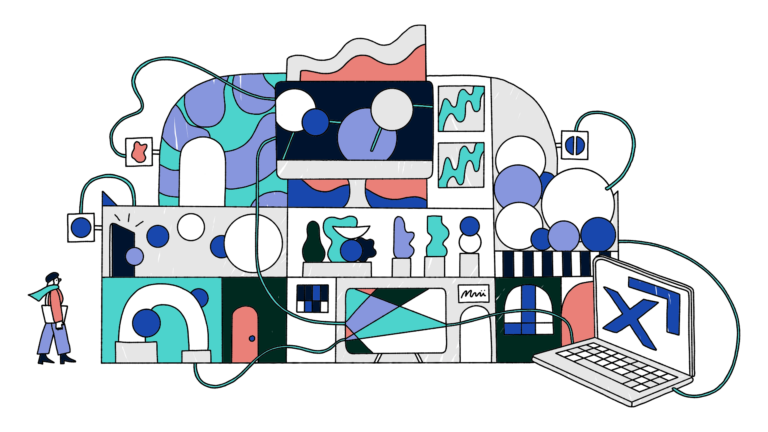Understanding AI and machine learning in advertising
Machine learning and artificial intelligence, or AI, have become buzzwords, especially in advertising. Although they’re sometimes used interchangeably, they have distinct meanings and applications for our industry.
First, let’s understand what these terms mean. AI is a broad concept referring to computers performing tasks that typically require human intelligence—things like recognizing speech, sorting data, making decisions, or understanding language.
Machine learning, or ML, is a specific application or subset of AI. It enables machines to learn and improve on their own without needing explicit instructions for every task.
Machine learning uses algorithms, or sets of instructions that are designed to analyze large amounts of data, recognize patterns, and make decisions based on those patterns.
How do machine learning algorithms work?
Imagine you’re teaching a machine to identify whether an image contains a dog. Initially, you provide a lot of labeled images—some with dogs and some without. The algorithm looks for patterns like shapes, colors, or textures, that are common in images containing dogs.
The more data the algorithm is exposed to as it’s trained, the smarter it becomes. In this case, as the algorithm processes more images, it becomes better at recognizing dogs—even in situations it’s never seen before, like a dog wearing a hat.
This is why machine learning presents such an immense opportunity in digital advertising.
Because ad tech powers the open internet, it processes a massive amount of data—just at Index alone, we process about two petabytes of data every day. That’s about the equivalent of streaming Netflix in HD non-stop for 80 years, give or take.
Why machine learning matters in programmatic advertising
Without ML, ad tech platforms (and the media owners and marketers who rely upon them) are limited in the amount of data they’re able to consume and analyze quickly. In a typical programmatic bidding process, that ocean of data is released like a firehose, leaving the marketer to try to catch what it can, often missing valuable insights. Imagine that capacity is the size of a thimble, compared with an ocean-sized amount of data.
Machine learning, however, offers a new capacity for analyzing that firehose of available data and combining it with marketers’ campaign data to more efficiently and effectively target the right audience, in the right place, at the right time, with the right message.
As these algorithms are exposed to more data—like click rates, conversion metrics, or consumer behaviors—they get better at delivering ads that are more relevant and effective.
The expanding role of machine learning in advertising
Machine learning has been part of the evolving programmatic advertising ecosystem for years now—for example, it’s been used to create bidding algorithms for marketers, for curation, or for traffic optimization.
But advances in technology and computing efficiency are creating new, potentially transformative opportunities, which is why you’re hearing so much about ML now.
This potential is especially valuable today because the industry is facing signal loss such as restrictions on the use of third-party cookies and other identifiers. Algorithms can efficiently find more performant opportunities, helping marketers optimize budgets, drive stronger outcomes, and provide better consumer experiences.
Traditionally, machine learning algorithms have been applied on the buy side of the ecosystem within the DSP. Today, there’s a significant shift in applying ML on the sell side through SSPs. This shift evolves decision-making from a reactive process to a proactive one and unlocks new levels of efficiency and precision in doing so.
By nature, SSPs tend to see all ad requests from the media owners they support, representative of the open internet. By training models with that level of scale, ML can turn vast amounts of data into actionable intelligence before a bid is even placed, allowing marketers to anticipate performance and make smarter decisions earlier in the supply chain.
Consider what this means in the case of ML-powered curation: Activating scarce audience signals across all of the open internet makes it easier to find more matchable opportunities and achieve greater reach. Campaigns can be optimized before they even reach the DSP, where they can then be even further enhanced.
Another opportunity comes from how advances in ML capabilities and computing efficiencies enable companies to take control of their data and unique assets to generate more value for their businesses. Rather than relying on off-the-shelf algorithms, it’s now feasible for companies to fully customize their own algorithms based on their unique data and activate them on the sell side, leading to better performance and efficiency.
The benefits of machine learning in advertising
Harnessing the power of ML across both the buy and sell sides creates more opportunities for optimization. This ensures better results for everyone across the ecosystem.
The benefits can include:
• More efficiency with fewer wasted bid requests
• Better performance and higher ROI for marketers
• More revenue for media owners
• Sustainability gains through reduced computing power and lower carbon footprints
• More relevant consumer experiences, ensuring that advertising continues to fund access to the open internet and free media
Machine learning is already transforming advertising as we know it. As it continues to evolve, we have the power to create smarter, more sustainable, and more effective advertising strategies that benefit everyone.
Start leveraging machine learning to optimize your campaigns and drive better results. Reach out to our team to get started.









